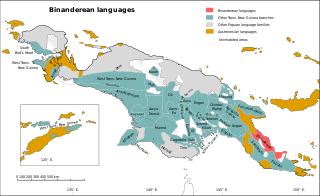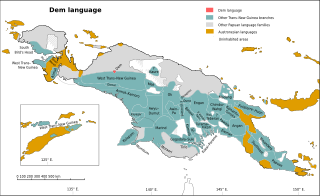Related Research Articles
The Lihir language is an Austronesian language spoken in the Lihir island group, in New Ireland Province, Papua New Guinea. It is notable for having five levels of grammatical number: singular, dual, trial, paucal and plural. It is questionable whether the trial is indeed trial or whether it is paucal, leaving there being a paucal and a greater paucal. Either way, this is the highest number of levels of grammatical number in any language. This distinction appears in both independent pronouns and possessor suffixes. There is some variation in pronunciation and orthography between the main island Niolam, and some of the smaller islands in the group.

Senegal is a multilingual country: Ethnologue lists 36 languages, Wolof being the most widely spoken language.
The Kutubuan languages are a small family of neighboring languages families in Papua New Guinea. They are named after Lake Kutubu in Papua New Guinea.

The Chimbu–Wahgi languages are a language family sometimes included in the Trans–New Guinea proposal.

The Engan, or more precisely Enga – Southern Highland, languages are a small family of Papuan languages of the highlands of Papua New Guinea. The two branches of the family are rather distantly related, but were connected by Franklin and Voorhoeve (1973).

The Greater Binanderean or Guhu-Oro languages are a language family spoken along the northeast coast of the Papuan Peninsula – the "Bird's Tail" of New Guinea – and appear to be a recent expansion from the north. They were classified as a branch of the Trans–New Guinea languages by Stephen Wurm (1975) and Malcolm Ross (2005), but removed by Timothy Usher (2020). The Binandere family proper is transparently valid; Ross connected it to the Guhu-Semane isolate based on pronominal evidence, and this has been confirmed by Smallhorn (2011). Proto-Binanderean has been reconstructed in Smallhorn (2011).

The Finisterre–Huon languages comprise the largest family within the Trans–New Guinea languages (TNG) in the classification of Malcolm Ross. They were part of the original TNG proposal, and William A. Foley considers their TNG identity to be established. The languages share a small closed class of verbs taking pronominal object prefixes some of which are cognate, strong morphological evidence that they are related.
The Doga language is an Austronesian language spoken by about 200 people along Cape Vogel in the Milne Bay Province of Papua New Guinea.
The Seimat language is one of three Western Admiralty Islands languages, the other two being Wuvulu-Aua and the extinct Kaniet. The language is spoken by approximately 1000 people on the Ninigo and the Anchorite Islands in western Manus Province of Papua New Guinea. It has subject–verb–object (SVO) word order.

Dem is a divergent Papuan language of West New Guinea. Although Palmer (2018) leaves it unclassified, it was tentatively included in the Trans–New Guinea family in the classification of Malcolm Ross (2005), and Timothy Usher ties it most closely to Amung.
Tofanma or Tofamna is a poorly documented Papuan language of Indonesia. Wurm (1975) placed it as an independent branch of Trans–New Guinea, but Ross (2005) could not find enough evidence to classify it. It appears to be related to Namla, a neighboring language.
Mombum, or Kemelom (Komolom), is a Trans–New Guinea language spoken on Yos Sudarso Island in West New Guinea.
Terebu (Turubu) is one of three Kairiru languages spoken in East Sepik Province, Papua New Guinea. It is spoken in Turubu village of Turubu Rural LLG, East Sepik Province.
Tumleo is an Austronesian language of coastal Sandaun Province, Papua New Guinea, on Tumleo Island and the Aitape coast in East Aitape Rural LLG.
Mwatebu is an Austronesian language spoken in a single village in the D'Entrecasteaux Islands of Papua New Guinea. It is spoken in the single village of Mwatebu in Duau Rural LLG, Milne Bay Province.
Enga Sign Language is an apparent village sign language among the Tato Enga people in Enga province, Papua New Guinea. It was reported in 1980 in three articles by Adam Kendon, based on ethnographic films of three signers in the upper valley of the Lagaip River, but with reports of wider use in the surrounding region. Its current status is unknown, as no more recent information is available.
Mount Avejaha Sign Language is a village sign language of Papua New Guinea. It is spoken in a remote village with many deaf children in the foothills of Mount Avejaha, in Oro Province. It is dissimilar from other village sign languages in New Guinea. The deaf are well integrated into the community.
Kailge Sign Language is a well-developed village sign language of Western Highlands Province, Papua New Guinea. It is spoken over a wide region of small hamlets around the town of Kailge, as well as in Kailge itself, in a Ku Waru–speaking region. It might be characterized as a network of homesign rather than as a single coherent language. Its use of signing space is more similar to that of deaf-community sign languages than that of many village sign languages shared with the hearing community.
Sinasian Sign Language (SSSL) is a village sign language of the Sinasina valley in Chimbu Province, Papua New Guinea. This language is used by approximately 3 deaf and 50 hearing individuals, including members of the Kere community. SSSL was first encountered and reported by linguist Samantha Rarrick in 2016. Documentation efforts are ongoing.
Wanib Sign Language is a reported sign language, possibly a village sign language, in a Heyo-speaking community of Papua New Guinea. It's spoken just to the west of Mehek Sign Language, but the two languages reflect the very different spoken languages of their communities: Wanib SL follows the SVO word order of Heyo, whereas Mehek SL follows the SOV word order of Mehek.
References
- ↑ Badyara at Ethnologue (26th ed., 2023)

- ↑ Wilson, William André Auquier. 2007. Guinea Languages of the Atlantic group: description and internal classification. (Schriften zur Afrikanistik, 12.) Frankfurt am Main: Peter Lang.